Little things amount to millions in savings – Green Tourism conference
Written by Tim Greenhalgh
Posted on November 12, 2014
The little, simple things can quickly mount up to millions savings is the message we shared at the Green Tourism conference in Manchester.
The Palace Hotel venue was packed with delegates from many sectors in the tourism industry, from eco brands to football clubs, hotel groups and independents.
John Bragger, Head of Field Services at SaveMoneyCutCarbon.com, shared the main “no brainers” – simple, small steps in energy saving and water efficiency that would quickly add up for any business seeking to control rising bills, cut carbon and build a more sustainable platform for long-term development.
John advised, during the three energy saving sessions, that we had ensured that our customers are benefiting from more than £1 million savings on energy and water bills over the next year.
- These energy savings are equivalent to taking 2,800 families off the National Grid for a year.
- The carbon emissions reduction is equivalent to taking 1,200 cars off UK roads for a year
- The water saved would fill around 68 Olympic sized swimming pools.
Delegates learned that a simple, cost-effective energy saver is to cut water consumption because this reduces electricity needed to heat and pump the water. Quality eco shower heads that mix air with water flow are a simple, effective solution, reducing water consumption by more than 50% and so cutting energy use.
The same principle applies to taps – fitting eco taps which have similar technology to that used in the best eco shower heads cut consumption by more than 50%, so directly save money on heating and pumping. And tap aerators are an excellent option for energy saving, again reducing water use by more than 50% with no perceived effect on flow quality.
Here’s a graphic savings example from our session:

The second but equally important no brainer is to address energy wasted in lighting by replacing energy-guzzling light bulbs, spotlights, downlights, tubes and any exterior floodlighting with LED versions.
The light emitting diode technology ensures that you can save up to 85% on your lighting bills and the initial expense is repaid quickly, often inside 12 months. The longevity of LEDs means that there is zero maintenance and a quality brand should last for up to 50,000 hours. The unique build-quality of LEDs means that, unlike traditional bulbs, they are immune to vibration.
What’s more they can be closely controlled with no deterioration, so you can use occupancy or daylight sensors to turn them on and off, up and down as often as needed.
Just be sure to avoid going for CFL energy-saving solutions. These contain harmful elements, have generally poorer light quality and do not last as long as LEDs. There are also excellent retrofit solutions for external lighting so if you have floodlights, it makes sense to choose an LED product.
A word of warning, though – there are many “budget” LEDs on the market but they are too often not even worth the packaging used with low quality control at production time. In fact, some “cheap-as-chips” models have been shown to be dangerous, badly wired and so able to deliver a massive shock.
John further underlined the need for trusted solutions providers in lighting by reminding delegates of the importance of safety regulations and Plan B compliance when planning and installing an LED lighting retrofit.
His other top tips:
- Automate where possible – save while no one notices
- Work with products from proven and major brands
- Beware of unbelievable warranties – if it is too good to be true, it probably is!
- Measure your starting point and create sound business cases, with conservative data assumptions
- Do not forget installation – an energy or water saving product saves you nothing if it remains in the box or is installed badly
- Pick off low hanging fruit easy retrofits areas
- Right product for right purpose – especially with LED
- A partnership approach is required for larger projects.
Finally, the growing importance of energy efficiency cannot be overlooked simply because of the growing number of government interventions and regulations, as well as the need to minimise costs through reduced consumption and lower maintenance. Moving beyond compliance is the next logical step for businesses.
There are so many positive sides to the drive for energy efficiency and better water management, not least the impact on sustainability strategies within Corporate Social Responsibility frameworks.
As John advised, working with an experienced partner any business should see a clear and ongoing benefit to the bottom line.
More on Green Tourism here.